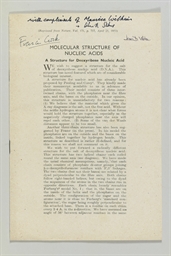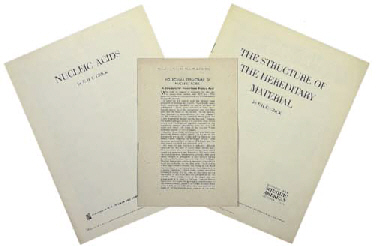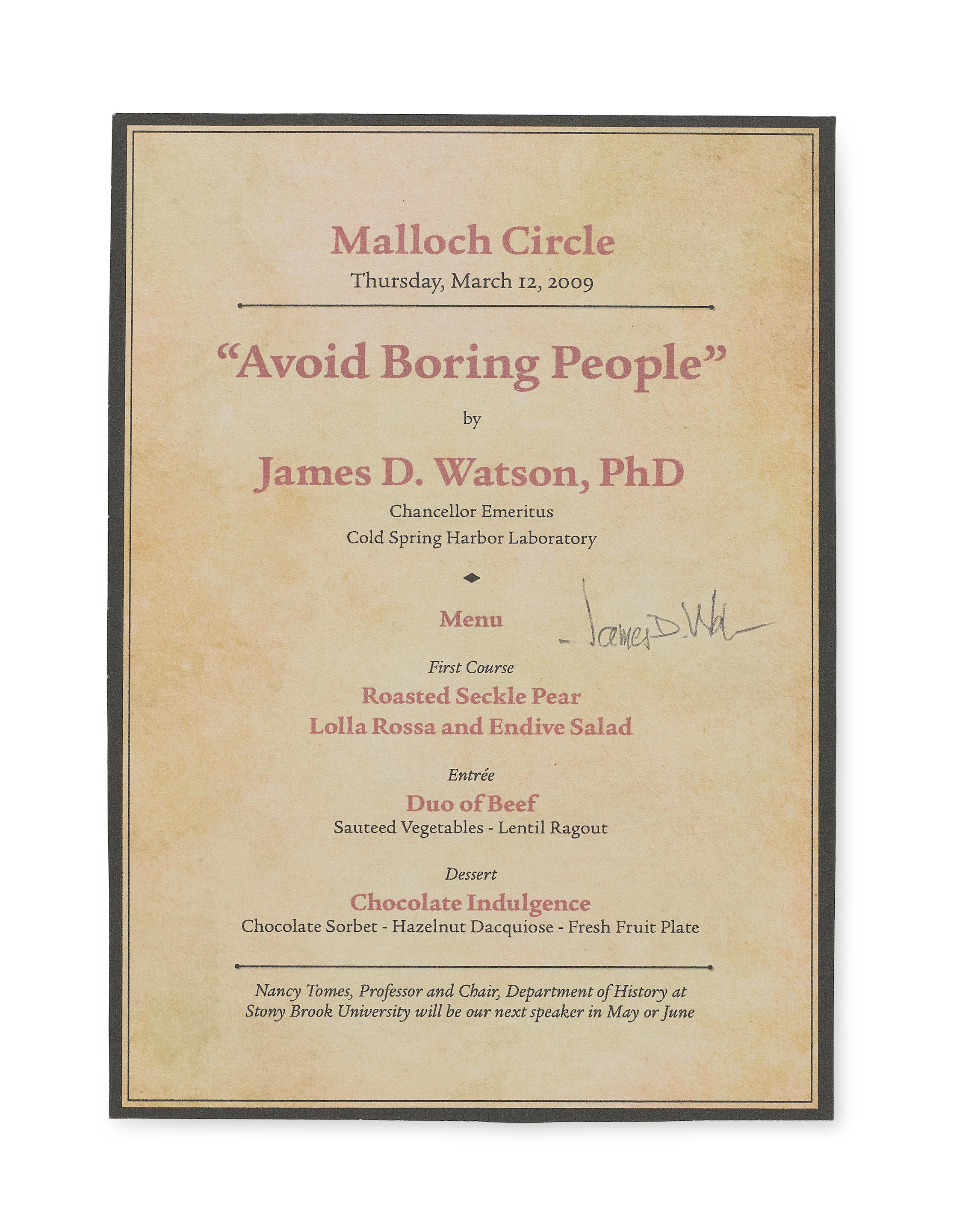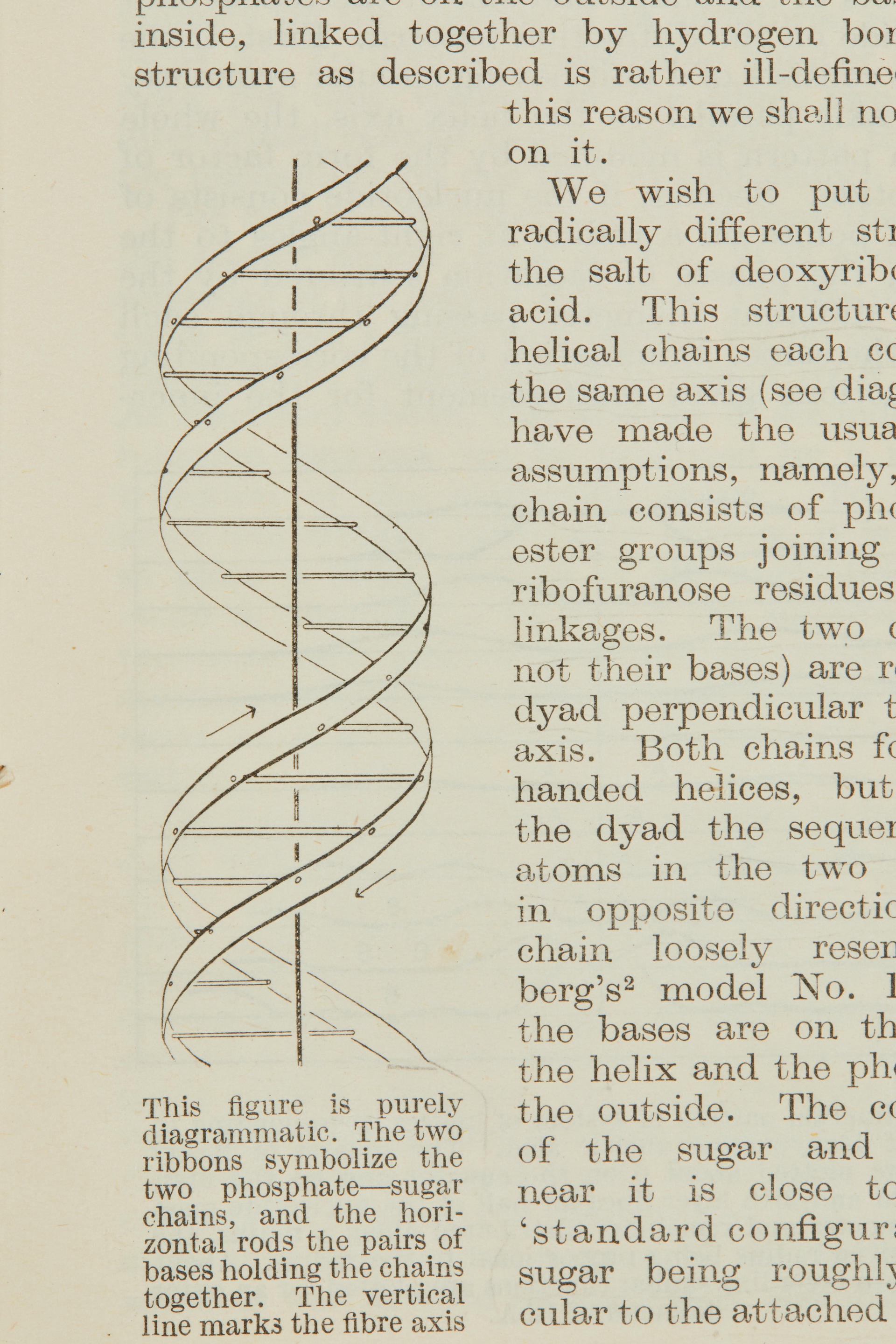WATSON, James Dewey]. Nobel Prize Medal in Medicine or Physiology for his work on the discovery of DNA’s structure. 23 carat gold, 66 mm diameter (approx. 2 5/8 in.). Profile bust of Alfred Nobel facing left on obverse, with “ALFR. NOBEL” at left and his dates in Roman numerals at right, signed along lower left edge (incuse) “E. LINDBERG 1902”, reverse with allegorical vignette showing the figure of Science unveiling Nature, signed at right “E. LINDBERG”, legend “INVENTAS VITAM IUVAT EX COLUISSE PER ARTES” around edge, “J. D. WATSON / MCMLXII” engraved below on plaque, with caption “REG UNIVERSITAS – MED CHIR CAROL” on either side of the plaque; rim marked “GULD 1950” (Kungliga Mynt och Justeringsverket [Swedish Royal Mint]); housed in original red morocco gilt case, interior lined in tan suede and satin.
WATSON, James Dewey]. Nobel Prize Medal in Medicine or Physiology for his work on the discovery of DNA’s structure. 23 carat gold, 66 mm diameter (approx. 2 5/8 in.). Profile bust of Alfred Nobel facing left on obverse, with “ALFR. NOBEL” at left and his dates in Roman numerals at right, signed along lower left edge (incuse) “E. LINDBERG 1902”, reverse with allegorical vignette showing the figure of Science unveiling Nature, signed at right “E. LINDBERG”, legend “INVENTAS VITAM IUVAT EX COLUISSE PER ARTES” around edge, “J. D. WATSON / MCMLXII” engraved below on plaque, with caption “REG UNIVERSITAS – MED CHIR CAROL” on either side of the plaque; rim marked “GULD 1950” (Kungliga Mynt och Justeringsverket [Swedish Royal Mint]); housed in original red morocco gilt case, interior lined in tan suede and satin. Prior to 1980 the Nobel Prize medal was made from 23 carat gold, but since then Nobel Prize medals are made of 18 carat green gold plated with 24 carat gold. The diameter of the Nobel Prize medal is 66 mm but the weight and thickness varies with the price of gold. The average Nobel Prize medal is 175 g with a thickness ranging from 2.4-5.2 mm. Both sides of most of the categories of Nobel medals are the same, showing the image of Alfred Nobel and the years of his birth and death. However, the verso of the Physiology or Medicine medal is different (as here), depicting the goddess of medicine quenching the thirst of a sick girl. The medals for Physics, Chemistry, Physiology or Medicine and Literature were modeled by the Swedish sculptor and engraver Erik Lindberg (1873-1966). According to his will, the Swedish inventor Alfred Nobel established the prizes in 1895, and the prizes in Physics, Chemistry, Physiology or Medicine, Literature, and Peace were instituted in 1901. (The related Nobel Memorial Prize in Economic Sciences was created in 1968.) While the initial five prizes are awarded in Stockholm, the Nobel Peace Prize is presented in Oslo. The Nobel Prize is widely regarded as the most prestigious award available in the fields of literature, medicine, physics, chemistry, peace, and economics. The Nobel Prizes in Physics, Chemistry, and Economic Sciences are awarded by the Royal Swedish Academy of Sciences; the Nobel Prize in Physiology or Medicine is awarded by the Nobel Assembly at Karolinska Institutet; the Nobel Prize in Literature is awarded by the Swedish Academy; and the Nobel Peace Prize is awarded by the Norwegian Nobel Committee. Awarded annually, each laureate receives a gold medal, a diploma and a sum of money, which is decided by the Nobel Foundation. In 1962, the Nobel Prize in Physiology or Medicine was awarded jointly to Francis Harry Compton Crick, James Dewey Watson and Maurice Hugh Frederick Wilkins “for their discoveries concerning the molecular structure of nucleic acids and its significance for information transfer in living material.” Maurice Wilkins’s colleague Rosalind Franklin (1920–1958), whose data and research using X-ray diffraction images of DNA were essential to Crick and Watson’s determining its structure and formulating their double-helical model, died of cancer at the age of 37, and was therefore not so honored because the Nobel Prize cannot be shared by more than three scientists, nor can it be awarded posthumously.
WATSON, James Dewey]. Nobel Prize Medal in Medicine or Physiology for his work on the discovery of DNA’s structure. 23 carat gold, 66 mm diameter (approx. 2 5/8 in.). Profile bust of Alfred Nobel facing left on obverse, with “ALFR. NOBEL” at left and his dates in Roman numerals at right, signed along lower left edge (incuse) “E. LINDBERG 1902”, reverse with allegorical vignette showing the figure of Science unveiling Nature, signed at right “E. LINDBERG”, legend “INVENTAS VITAM IUVAT EX COLUISSE PER ARTES” around edge, “J. D. WATSON / MCMLXII” engraved below on plaque, with caption “REG UNIVERSITAS – MED CHIR CAROL” on either side of the plaque; rim marked “GULD 1950” (Kungliga Mynt och Justeringsverket [Swedish Royal Mint]); housed in original red morocco gilt case, interior lined in tan suede and satin.
WATSON, James Dewey]. Nobel Prize Medal in Medicine or Physiology for his work on the discovery of DNA’s structure. 23 carat gold, 66 mm diameter (approx. 2 5/8 in.). Profile bust of Alfred Nobel facing left on obverse, with “ALFR. NOBEL” at left and his dates in Roman numerals at right, signed along lower left edge (incuse) “E. LINDBERG 1902”, reverse with allegorical vignette showing the figure of Science unveiling Nature, signed at right “E. LINDBERG”, legend “INVENTAS VITAM IUVAT EX COLUISSE PER ARTES” around edge, “J. D. WATSON / MCMLXII” engraved below on plaque, with caption “REG UNIVERSITAS – MED CHIR CAROL” on either side of the plaque; rim marked “GULD 1950” (Kungliga Mynt och Justeringsverket [Swedish Royal Mint]); housed in original red morocco gilt case, interior lined in tan suede and satin. Prior to 1980 the Nobel Prize medal was made from 23 carat gold, but since then Nobel Prize medals are made of 18 carat green gold plated with 24 carat gold. The diameter of the Nobel Prize medal is 66 mm but the weight and thickness varies with the price of gold. The average Nobel Prize medal is 175 g with a thickness ranging from 2.4-5.2 mm. Both sides of most of the categories of Nobel medals are the same, showing the image of Alfred Nobel and the years of his birth and death. However, the verso of the Physiology or Medicine medal is different (as here), depicting the goddess of medicine quenching the thirst of a sick girl. The medals for Physics, Chemistry, Physiology or Medicine and Literature were modeled by the Swedish sculptor and engraver Erik Lindberg (1873-1966). According to his will, the Swedish inventor Alfred Nobel established the prizes in 1895, and the prizes in Physics, Chemistry, Physiology or Medicine, Literature, and Peace were instituted in 1901. (The related Nobel Memorial Prize in Economic Sciences was created in 1968.) While the initial five prizes are awarded in Stockholm, the Nobel Peace Prize is presented in Oslo. The Nobel Prize is widely regarded as the most prestigious award available in the fields of literature, medicine, physics, chemistry, peace, and economics. The Nobel Prizes in Physics, Chemistry, and Economic Sciences are awarded by the Royal Swedish Academy of Sciences; the Nobel Prize in Physiology or Medicine is awarded by the Nobel Assembly at Karolinska Institutet; the Nobel Prize in Literature is awarded by the Swedish Academy; and the Nobel Peace Prize is awarded by the Norwegian Nobel Committee. Awarded annually, each laureate receives a gold medal, a diploma and a sum of money, which is decided by the Nobel Foundation. In 1962, the Nobel Prize in Physiology or Medicine was awarded jointly to Francis Harry Compton Crick, James Dewey Watson and Maurice Hugh Frederick Wilkins “for their discoveries concerning the molecular structure of nucleic acids and its significance for information transfer in living material.” Maurice Wilkins’s colleague Rosalind Franklin (1920–1958), whose data and research using X-ray diffraction images of DNA were essential to Crick and Watson’s determining its structure and formulating their double-helical model, died of cancer at the age of 37, and was therefore not so honored because the Nobel Prize cannot be shared by more than three scientists, nor can it be awarded posthumously.












Testen Sie LotSearch und seine Premium-Features 7 Tage - ohne Kosten!
Lassen Sie sich automatisch über neue Objekte in kommenden Auktionen benachrichtigen.
Suchauftrag anlegen